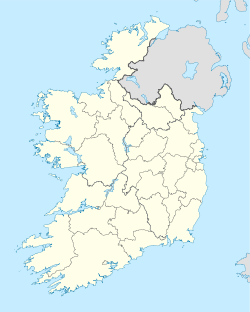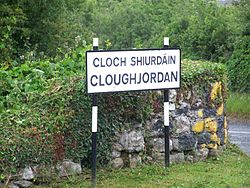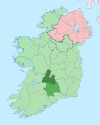- Cloughjordan
-
Cloughjordan
Cloch Shiurdáin— Town — Location in Ireland Coordinates: 52°56′25″N 8°02′08″W / 52.9402778°N 8.0355556°WCoordinates: 52°56′25″N 8°02′08″W / 52.9402778°N 8.0355556°W Country Ireland Province Munster County County Tipperary Elevation 380 m (1,247 ft) Time zone WET (UTC+0) – Summer (DST) IST (WEST) (UTC-1) Irish Grid Reference R9761087713 Cloughjordan, officially Cloghjordan[1] (
 /klɒkˈdʒɔrdən/ klok-jor-dən, Irish: Cloch Shiurdáin, meaning "Siurdáin's stone"), is a town in North Tipperary in Ireland. It is in the barony of Ormond Lower, and it is also a parish in the Roman Catholic Diocese of Killaloe.[2]
/klɒkˈdʒɔrdən/ klok-jor-dən, Irish: Cloch Shiurdáin, meaning "Siurdáin's stone"), is a town in North Tipperary in Ireland. It is in the barony of Ormond Lower, and it is also a parish in the Roman Catholic Diocese of Killaloe.[2]The town is situated in the north-western part of North Tipperary close to the Offaly border. It is almost equidistant from Nenagh, Roscrea and Birr and is close to Ireland's largest river, the Shannon, and Lough Derg.
Poet and patriot Thomas McDonagh, a native of Cloughjordan, described it as a place “in calm of middle country”.
Unusually for a town of its size (the 2002 Census Records places the population at 431), it has three churches – Roman Catholic (SS. Michael and John’s, built in 1898), Church of Ireland (St. Kieran’s, 1837) and Methodist (1875).
The alternate spelling is recognised.
Contents
History
Developed at the intersection of travel routes between Nenagh, Birr and Moneygall, the village of Cloughjordan began as an inhabited settlement during the Norman lordship of Ireland of the 13th and 14th centuries when the De Marisco family were allotted land in Ormond under the overlordship of the Butlers by King Henry II. One unit of the De Mariscos (Morris or Morrissey in modern terms) moved into this area, took over the territory and built a stone castle and manor house guarded by a moat surrounding the dwelling.
There is a story which relates that the first De Marisco, who resided here, was a Norman knight who had travelled to the Holy Land to take part in a Crusade against the Saracen invaders. He is said to have brought back a stone from the River Jordan which he built in over the doorway of this castle and it was from that stone that the village got its name – the Stone of Jordan – Clogh Shiúrdáin – Cloughjordan.
Cloughjordan was further developed in the late 17th century by Cromwellian grantees when Colonel John Harrison, an officer in Cromwell's army, was granted an estate of 1,484 acres (6.01 km2) of land around Cloughjordan in payment for his military services. Harrison built a house, now known as Cloughjordan House, at the site of the original Norman Castle of De Marisco and incorporated the old castle into the new building, in which one wall of the castle, about seven and a half feet thick, is still in existence to this day.
Cloughjordan was then remodelled in the late 18th century to include a square in front of the Church of Ireland on the east-west main street.
In 1909 Cloughjordan was one of the first villages in Ireland, after Carlow and Birr, to provide its own rural electrification scheme. The ESB took over the supplying of electricity to the town in 1948.
Transport
Cloughjordan railway station opened on 5 October 1863.[3] It is connected to the Irish railway network on a branch from Limerick to Ballybrophy (where it joins the main Cork–Dublin line) and has a twice-daily service in each direction.
Sport
- Kilruane McDonaghs GAA is the local Gaelic Athletic Association club.
- Cloughjordan also has a Soccer Club that competes in the North Tipperary & District League.
People
- Patrick Bergin, actor, resides in Cloughjordan.
- Fergus Costello is an internationally acclaimed liturgical artist and church designer. He is a leading authority on Church art in Ireland and is based out of Cloughjordan.
- Michael Joseph Costello, Military General, born 1904 in Cloughjordan.
- Len Gaynor, former hurling player and manager born 1944 in Cloughjordan.
- Thomas MacDonagh, poet and patriot, born in Cloughjordan, was one of the signatories of the 1916 Proclamation of the Republic. He was executed in 1916 by firing squad. The local library and Gaelic Athletic Association park bear his name.
- Tom Moloughney, former hurling player, born 1940 in Cloughjordan.
- Éamonn O'Shea, former hurling player and coach,born 1958 in Cloughjordan
- Charlie Swan, multiple National Hunt Champion jockey.
- John Talbot, Canadian Reformer and schoolmaster, born 1797 in Cloughjordan.
Buildings of note
Whilst there are other buildings of architectural interest in and around Cloughjordan, the following are featured in 'An Introduction To The Architectural Heritage Of North Tipperary'[4] and on the National Inventory of Architectural Heritage website [5] See also "The Evolution And Architecture Of Cloughjordan 1841 to 1901" [6]
- Cloughjordan House, Step Road. Oxpark (c1675) C17th house built on to existing tower house, further extended in C18th.
- Mullenkeagh House, Borrisokane Rd. Detached two storey house, renovated early C19th in Georgian style but still contains many of its original features. (originally c1700, remodeled c1800)[7]
- Former Steward's house, Step Rd/Moneygall Rd. (c1770)
- Milestone, Main St/Moneygall Rd.(c1780)
- Bridge at Modreeny, Modreeny Estate (c1790) Cast iron parapets between cut limestone piers surmounted at one end by eagles, at the other by urns.
- Houses, formerly The Barracks (also known as the Militia Houses),[8] The Square (c1800) Built as a three storey barracks and later converted to housing. Original outbuildings to rear. The Meadow (or Square) was planned as an adjoining parade ground.
- Former Mill, Step Rd. (c1800)
- Distillery Cottage, Borrisokane Rd. Mullenkeagh. Single storey cottage built for the manager of the adjacent though now ruined, distillery. (c1820)[9]
- St Kieran's Church of Ireland church, The Square (1837) Designed by James and George Richard Pain for the Board of First Fruits. A cut stone spire surmounts the centrally placed entrance on to the Meadow (or Square).
- The Old Presbytery, Borrisokane Rd. (c1830)
- Former Hotel, Main St. (c1855)
- Cloughjordan railway station, Townfields Townland (1863) Cluster of structures, the classically influenced station building, station masters house and road bridge over the tracks.
- Cloughjordan Methodist Church, Main St. (1875) Modest church building with polychromic tiling.
- SS Michael and John's Roman Catholic Church, Moneygall Rd. (c1898) See stained glass windows from the studio of Harry Clarke, behind the altar, and Evie Hone, to the side of the altar.
- Modreeny House, Eminiska (c1920) Home built c 1920 in Arts and Crafts style to replace previous C18th house.
- Former Bank, Step Rd. (c1925)
- Various houses & former shops, Main St. (c1820-1900)
Recent developments
- The Village[10] is a project with the aim of creating an "eco-village" community with commitments to ecological, social and economic sustainability. This new community, being developed on 67 acres (270,000 m2) of farmland, will merge with the existing village of Cloughjordan through a new street opposite the Church of Ireland. Irish Times, June 7, 2006: "Green Town Breaks Ground" The first residents moved into their homes in the eco-village in Dec 2009.[11]
- The Cloughjordan Cineclub was officially launched on August 25, 2005 - some forty-four years since a film had last been screened in Cloughjordan.[12]
- Cloughjordan community farm was established in 2008 with members drawn from the surrounding area. The farm aims to supply member's families with much of their food using organic and biodynamic principles.[13]
- A 500m2 array of panels for solar water heating, the largest in Ireland, was launched in May 2011. The solar panels will provide additional hot water for the community heating system which is presently powered by a wood chip boiler. The boiler serves houses in the eco-village.[14]
- A street market takes place at the meadow every second Saturday.[15]
See also
References
- ^ Placenames Database of Ireland
- ^ Parishes of Killaloe Diocese.
- ^ "Cloughjordan station". Railscot - Irish Railways. http://www.railscot.co.uk/Ireland/Irish_railways.pdf. Retrieved 2007-09-07.
- ^ An Introduction To The Architectural Heritage Of North Tipperary, ISBN 0755774442
- ^ http://www.buildingsofireland.ie/niah/search.jsp?county=TN&name=&town=cloughjordan&townland=&type=quick&page=1
- ^ A 2008 thesis, "The Evolution And Architecture Of Cloughjordan 1841 to 1901" by L M. Mounsey is available for reference in Cloughjordan library
- ^ http://www.buildingsofireland.ie/niah/search.jsp?type=record&county=TN®no=22304002
- ^ http://www.cloughjordan.ie
- ^ http://www.buildingsofireland.ie/niah/search.jsp?type=record&county=TN®no=22304001
- ^ http://www.thevillage.ie
- ^ www.thevillage.ie
- ^ http://cloughjordancineclub.ning.com/
- ^ http://www.consultmark.ie/blog/2009/10/07/community-supported-agriculture-a-threat-to-retailers/
- ^ http://www.nenaghguardian.ie/search-articles-detail.php?article=K6RQPO
- ^ http://www.cloughjordan.ie/mainpage/index.htm
- "In and out of school – In the home of the MacDonaghs" by Roche Williams (2000).
External links
- Official Website
- Kilruane MacDonaghs GAA Club
- Tipperary Views
- The Village - Building a Sustainable Community
- Cloughjordan Library
- Cloughjordan Train Station
- Cloughjordan on OpenStreetMap
Places in North Tipperary Towns - Borrisokane
- Cloughjordan
- Nenagh
- Newport
- Roscrea
- Templemore
- Thurles
Villages Baronies - Eliogarty
- Ikerrin
- Kilnamanagh Upper
- Ormond Lower
- Ormond Upper
- Owney and Arra
- List of townlands in County Tipperary
- Category:Mountains and hills of County Tipperary
- Category:Rivers of County Tipperary
- Category:Geography of North Tipperary
- Baronies of Tipperary
Categories:- Parishes in Diocese of Killaloe
- Towns and villages in North Tipperary
Wikimedia Foundation. 2010.




